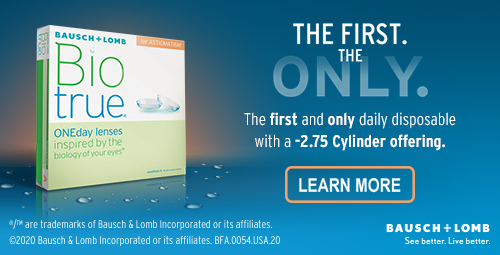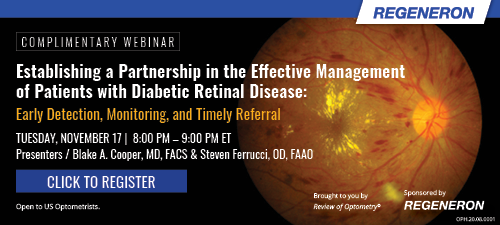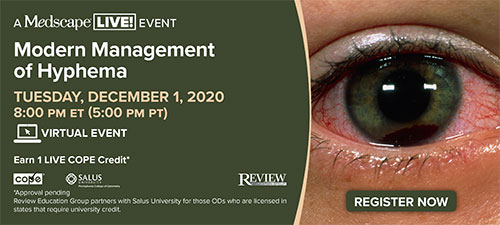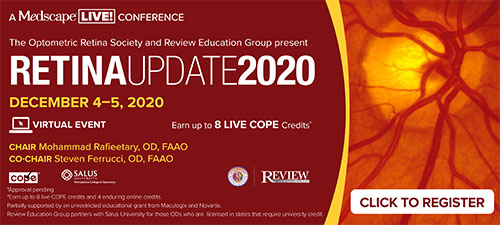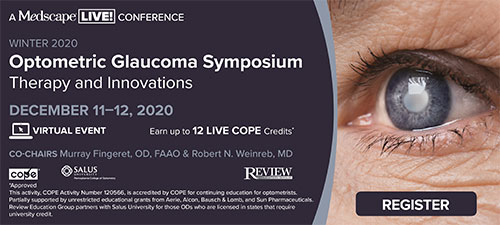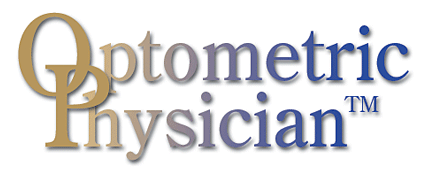
A
weekly e-journal by Art Epstein, OD, FAAO
Off the Cuff: COVID When Will It End?
Although I spend a significant amount of time following SARS COVID-2 from an epidemiology, infectious disease and practical perspective, it has been a while since I covered it. I think my track record has been pretty good so far. I quickly realized that transmission was airborne, strongly advocated mask wearing and antisocial distancing, recognized obsessive surface disinfection for the theatre it is and recommended the use of high-capacity HEPA filters in exam rooms. So far, my approach has been successful in our practice with no employee becoming infected despite extremely high levels of community infection in Phoenix.
|
|||||
 |
||
| Acute Corneal Edema Decades After Penetrating Keratoplasty for Keratoconus in Eyes Wearing Scleral Contact Lenses | ||||
This retrospective chart review of three scleral contact lens (ScCL) wearers presenting for sudden onset pain and blurred reported three cases of acute corneal edema occurring decades after penetrating keratoplasty (PK) for keratoconus. Data extracted included clinical presentation, year and reason for PK, ocular medications and comorbidities, contact lens wearing history; and results of any ancillary testing available including corneal topography, anterior segment optical coherence tomography (OCT) and specular microscopy surrounding the event; treatment and outcomes of intervention. The number of PK eyes fit with ScCLs in the author's practice was determined to estimate the prevalence of this event. The three patients each had a longstanding PK for keratoconus performed between 33 and 35 years prior to presentation and recurrent ectasia. Each patient presented with an acute, painful eye and reduced vision either three days, four months or nine years after refitting into ScCLs. Each eye had well-demarcated focal microcystic epithelial and stromal edema within the graft and crossing the wound margin onto the host cornea. Although a definitive break or detachment of Descemet's membrane was not visualized, the presentations suggested these were episodes of acute hydrops. |
||||
SOURCE: Murillo SE, Shariff A, Lass JH, et al. Acute corneal edema decades after penetrating keratoplasty for keratoconus in eyes wearing scleral contact lenses. Cont Lens Anterior Eye. 2020; Nov 4:S1367-0484(20)30179-X. |
||||
 |
||
| Association of Ocular Antihypertensive Medications and the Development and Progression of Age-related Macular Degeneration, in a US Insurance Claims Database | ||||
In this retrospective, observational cohort study using healthcare claims data from a US nationwide managed care network between January 1, 2006 and December 31, 2016, which included enrollees ≥40 years old with primary open-angle glaucoma with or without a diagnosis of nonexudative AMD at the index date, researchers assessed whether ocular antihypertensives were associated with development and progression of age-related macular degeneration (AMD). Hazard ratios (HR) for developing AMD or progressing from nonexudative to exudative AMD with exposure to ocular antihypertensive medications were analyzed.
|
||||
| SOURCE: Eton EA, Wubben TJ, Besirli CG, Wang SY. Association of ocular antihypertensive medications and the development and progression of age-related macular degeneration in a U.S. insurance claims database. Curr Eye Res. 2020 Nov 11.Epub ahead of print. | ||||
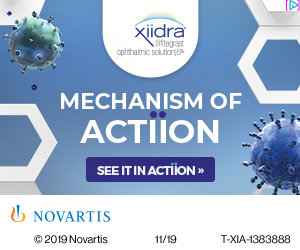 |
||
| Assessment of a Novel Lens Surface Treatment for Scleral Lens Wearers with Dry Eye | ||||
Investigators compared lens comfort and dry eye (DE) symptoms of DE scleral lens (SL) wearers’ fit with polyethylene glycol (PEG)-based surface-treated and untreated SLs. Dry eye signs, comfortable SL wearing time (WT), vision quality and lens-related ocular surface changes were also assessed. Twenty-one SL wearers with DE and SL discomfort were enrolled in a double-masked crossover study. Participants were randomized to wear untreated or PEG (Tangible Hydra-PEG, Tangible Science) surface-treated SL of the same parameters first for 30 days. Lens comfort, DE symptoms and ocular surface assessments were measured at baseline, after the first test period and after the crossover. Comfortable lens WT and frequency of foggy vision were recorded. Comparisons were assessed using paired T tests or Wilcoxon signed-rank tests. Polyethylene glycol-treated SL wear resulted in significantly improved lens comfort, DE symptoms, corneal sodium fluorescein staining, temporal conjunctival lissamine green staining, lid wiper epitheliopathy, conjunctival papillae, frequency of foggy vision, tear break-up time (TBUT) and comfortable lens WT compared with untreated wear. No significant changes were found between treated and untreated lens wear for TBUT over the SL and nasal conjunctival lissamine green staining. |
||||
| SOURCE: Mickles CV, Harthan JS, Barnett M. Assessment of a novel lens surface treatment for scleral lens wearers with dry eye. Eye Contact Lens. 2020; Nov 3. [Epub ahead of print.] | ||||
 |
||
| News & Notes | ||||||||
B+L: Nearly 27 Million Units of CL Materials Recycled by One By Ones
|
||||||||
| X-Cel Provides Eliminates Add-on Fees X-Cel’s new and simplified warranty and returns policy now includes the elimination of add-on fees, including charges for truncation, fenestration, lenticular, notching and prism, among others. Derrell James, vice president and general manager, said in a press release: “Permanently eliminating add-on fees provides that extra bit of breathing space eye care practitioners deserve now and in the future. Our customers don’t want to be nickel and dimed for every little thing when ordering their specialty contact lenses. We want to make their experience seamless, simple, cost effective and consistent.” Under this new policy, X-Cel also moved from a return fee upon credit to an exchange fee upon reorder to allow for simpler reconciliation of account statements. These changes were added to the existing Bounce Back program. Learn more. |
||||||||
| ScienceBased Health Expands Optometry Clinical Advisory Panel ScienceBased Health announced the addition of Tracy Doll, OD, FAAO; Scott Hauswirth, OD, FAAO; and Justin Schweitzer, OD, FAAO to its Clinical Advisory Panel. Dr. Doll is an assistant professor at Pacific University College of Optometry, and established and coordinates Pacific Dry Eye Solutions, an ocular surface dryness center of excellence at PUCO. Dr. Hauswirth is an assistant professor of ophthalmology at the University of Colorado School of Medicine, and coordinating director of the Ocular Surface Clinic. Justin Schweitzer, OD, FAAO, specializes in advanced glaucoma, refractive surgical clinical care and anterior segment pathology at Vance Thompson Vision.
|
||||||||
|
||||||||
|
||||||||
|
||||||||
|
||||||||
|
||||||||
|
||||||||
|
||||||||
|
Optometric Physician™ (OP) newsletter is owned and published by Dr. Arthur Epstein. It is distributed by the Review Group, a Division of Jobson Medical Information LLC (JMI), 19 Campus Boulevard, Newtown Square, PA 19073. HOW TO ADVERTISE |


